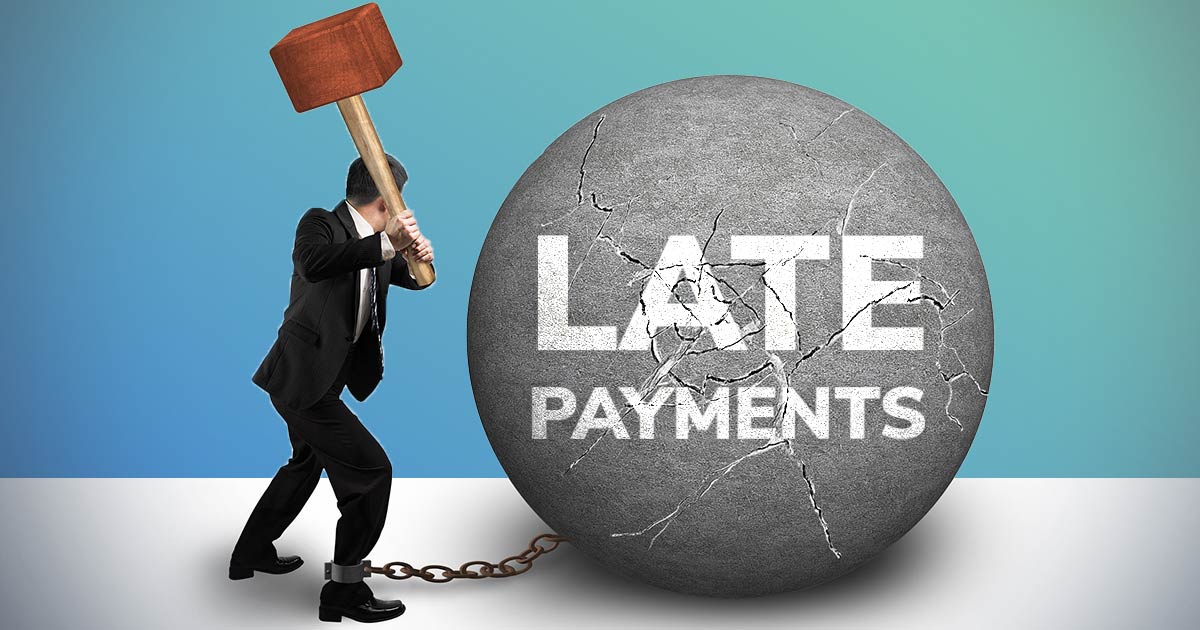In the unpredictable world of business, cash flow management stands as the sturdy compass that navigates a company's financial destiny.
Data shows that late payments are a growing problem for businesses worldwide. They've become a constant issue, not just a once-in-a-while problem. This affects how companies operate, make money, and have the chance to create new things and grow.
For small business owners, freelancers, and payment solution users, the question isn't merely about addressing late payments after they occur—it's about preventing late payments altogether. This comprehensive guide posits a little-known but highly effective solution for the late payment problem: the strategic importance of customer education.
The economic storm of late payments
Before we uncap the bottle of solutions, it's vital to understand the scale of the problem. Late payments act as a proverbial drain, siphoning invaluable resources from the veins of a business's financial health. According to global data, small businesses are owed an average of 25,000 USD in late payments, an alarming figure demonstrating late payments' far-reaching impact on business continuity.
The role of customer education: A proactive shield
Customer education is often cited for its ability to enhance customer satisfaction and loyalty, but its role in preventing late payments is less explored. By arming your customers with the knowledge they need to understand and adhere to payment processes, you're not just enhancing their user experience but crafting a robust barrier against the chaos late payments bring.
The importance of clear communication
In the battle against late payments, the war begins with communication. Too often, businesses falter with vague or buried payment terms, leading to misunderstandings that can later result in delays. Here, we dissect the art of clear communication:
- Simplified Language: Payment jargon can bewilder even the savviest customer. Communicating payment terms becomes approachable and actionable by simplifying language and using everyday terms.
- Transparency: Transparency is critical to cultivating trust with your customers. Clear invoices, disclosing payment policies, schedules, and potential consequences for late payments sets clear expectations and eliminates room for misinterpretations.
- Accessibility: Customer education can only be effective if it reaches its intended audience. Ensure payment-related information is easily accessible on your website, invoices, and other customer communication channels.
- Consistency: When it comes to payment procedures, consistency is essential. Ensure that the same policies and terms apply to all customers, regardless of their size or status. This establishes a level playing field and avoids any sense of preferential treatment.
- Highlighting Key Information: Invoices and contracts laden with small print are archenemies of clarity. By bolding or segregating payment terms, you're highlighting the essentials, ensuring they can't be missed.
Educating customers on payment processes
A well-informed customer is a paying customer. Consider implementing the following strategies for educating customers on payments:
- Onboarding Process: The onboarding payment process guide sets the tone for future customer interactions. Use this opportunity to highlight and explain payment terms and procedures thoroughly.
- Knowledge Base/FAQs: Create a knowledge base or FAQ section dedicated to addressing common payment-related queries. This not only empowers customers to find answers on their own but also reduces the burden on customer support.
- Payment Reminders: Sending timely payment reminders can help reduce instances of late payments. Use these reminders as an opportunity to educate customers on your payment processes and terms. Automated platforms like Chaser can streamline this process, eliminating the need for manual follow-ups.
- Incentives for Timely Payments: Consider offering discounts or other incentives for customers who make payments within a specified time
- Online Resources: Dedicated website sections or brochures can serve as educational hubs, offering a treasure trove of knowledge on how to complete payments.
- Step-by-Step Guides: Offer your customers precise instructions, walking them through the payment process step-by-step. This can be especially useful for first-time customers or complex payment procedures.
The benefits of payment reminders
Sometimes, a gentle nudge is all it takes. When timed and crafted skillfully, payment reminders can be the silent allies in your collection strategy.
- Personalization: Addressing customers by their name and tailoring the reminder to their unique payment history can resound with a personal touch that motivates timely payment.
- Automation: The power of automation lies in its ability to free up human resources while maintaining a consistent and timely line of communication that's crucial to the reminder's effectiveness.
- Flexibility: Automating payment reminders allows you to customize the frequency, timing, and messaging of follow-ups based on customer behavior and preferences.
- Instant payment links: Including a direct link to make payments in the reminder email can remove obstacles that may be preventing timely payment, such as difficulty navigating your website or finding relevant information.
Offering payment solutions
The choice is liberation, even in the world of payments. Diversifying your payment options caters to a broader audience and makes the process smoother.
- Digital wallets: The rising star of convenience, digital wallets can be a swift and secure alternative with multiple payment options, and educating customers about them is the first step to their adoption.
- Bank transfers: Facilitating direct bank transfers can simplify the payment process for customers who prefer this method. Highlighting its benefits, such as lower transaction fees and ease of payment, can motivate more customers to choose this option.
- Payment plans: Offering flexible payment plans can alleviate the burden of a lump-sum payment, making it easier for customers to fulfill their obligations.
- Automated payment platforms: As mentioned before, automated platforms like Chaser can streamline your collection strategy by automating reminders, offering multiple payment options, and providing real-time insights into late payments. This hands-off approach can save you time and resources while improving your cash flow.
Creating a culture of prompt payment
Incentives can be powerful motivators. Rewarding customers for prompt payments serves a dual purpose: enriching your customer relationship and cash flow.
- Discounts: Small incentives for prompt payment, in the form of a discount for early payment, can spark a significant change in payment behavior.
- Loyalty Points: An imaginative way to foster loyalty, adding points for each timely payment can turn a mundane activity into a building block of a prompt payment culture.
- Public Recognition: Customers love to be recognized for their allegiance. Consider showcasing your top-paying customers on your website or social media channels, offering them a chance to shine.
Shaping strategic customer education initiatives
A strategic approach to customer education transcends ad hoc efforts. It's about investing in a structured, long-term program that aligns with business objectives and augments your customer's experience.
Tailoring education to different audiences
Not all customers are created equal; the same goes for educational requirements. Tailoring your educational content to different customer segments ensures relevance and engagement.
- New customers: Welcome packets or onboarding sessions can introduce them to your payment processes and expectations. Consider offering discounts for their first payment to kickstart a positive relationship.
- Existing customers: Expand on existing educational initiatives by providing resources that cater to specific needs. For example, offer additional support and guidance if you notice a particular customer struggling with a specific payment method.
- Large customers: Large customers may require personalized education sessions or dedicated customer support to facilitate complex payment processes. Consider investing in specialized training for your team to serve these high-value customers better.
Leveraging technology for maximum impact
Technology can be a game-changer in the world of customer education, making it more accessible and engaging. Consider adopting the following technological tools to enhance your customer education initiatives:
- Interactive learning: Creating interactive modules or quizzes that customers can access through your website or mobile app can make learning fun and more effective.
- Webinars/Live demos: Real-time demonstrations of payment processes or Q&A sessions can provide in-depth knowledge while fostering a sense of community among your customers.
- E-Learning platforms: If you have an extensive library of educational content, consider investing in an e-learning platform for easy access and enhanced user experience.
Measuring the impact of education
What gets measured gets managed. By gauging the effectiveness of your educational initiatives, you can finetune and enhance them to maximize impact.
- Surveys: Direct customer feedback through surveys can provide valuable insights into the effectiveness of your educational materials.
- Payment metrics analysis: Tracking payment metrics pre- and post-education can act as an objective barometer for success.
- Customer retention: A decrease in late payments and an increase in customer retention can be strong indicators of the success of your education initiatives.
Leveraging technologies for widespread education
In the digital age, technology is the megaphone that amplifies your educational efforts. Utilizing online platforms and tools can ensure your education reaches far and wide.
- Webinars and online seminars: Interactive and engaging, these platforms can elucidate complex processes effectively. They're also cost-effective and eco-friendly.
- Video tutorials: Visuals are a potent tool for learning. Creating informative video tutorials on payment processes can help customers grasp concepts quickly.
- Educational apps: Gamification or interactive quizzes can inject an element of fun and encourage learning in a self-paced environment.
Building a knowledge sharing community
Strength lies in numbers. Building a community of educated customers can lead to peer-to-peer support and shared best practices. This community can also serve as a sounding board for new ideas and initiatives.
- Online forums: Discussion boards or forums dedicated to payment processes can foster interactions between customers, encouraging knowledge-sharing.
- Customer recognition: Publicly acknowledging customers who consistently adhere to your payment processes incentivizes them and sets an example for others in the community.
- Forums and groups: Hosting online forums or social media groups can foster discussions and knowledge exchange. Additionally, these platforms can serve as a direct line of communication with customers, allowing for immediate feedback and addressing any concerns.
Weaving education into your business fabric
The role of customer education in preventing late payments is not a fleeting trend but a fundamental pillar of modern business strategy. By embracing this tool, you're not just safeguarding your cash flow; you're strengthening your relationship with your customers, instilling a priceless sense of trust and reliability.
To take the first step in integrating customer education into your arsenal, start small, but start today. Whether it's revamping your invoices, launching a webinar series, or simply sending out personalized reminders, every educational effort contributes to the collective goal of a payment-prepared customer base.
In the end, it's not just about making payments—it's about making a difference. And with customer education, you're guiding your customers through the payment process and toward a future of satisfying transactions and fruitful partnerships.
The power of customer education
Customer education is often undervalued in its significance. Yet, it emerges as a pivotal tool for businesses to wield when it comes to deterring late payments. Integrating education into payment processes streamlines transactions and fosters a culture of conscientious financial behavior on both ends of the exchange.
In a world where every business interaction is an opportunity to teach, learn, and grow, those who seize the mantle of the educator pave the way for a future where late payments are a rarity, not a norm. Take this enlightenment and harness it within your business strategy, for in the end, it’s not just the payments you educate—it’s the future of your enterprise.
To find out how Chaser can support your payment recovery efforts and revolutionize the way you approach credit control, visit our website today. From personalized templates to automated reminders, Chaser offers a comprehensive solution for businesses of all sizes looking to tackle late payments head-on. Start your journey towards payment success with Chaser today by booking a demo or starting your 14-day free trial.




